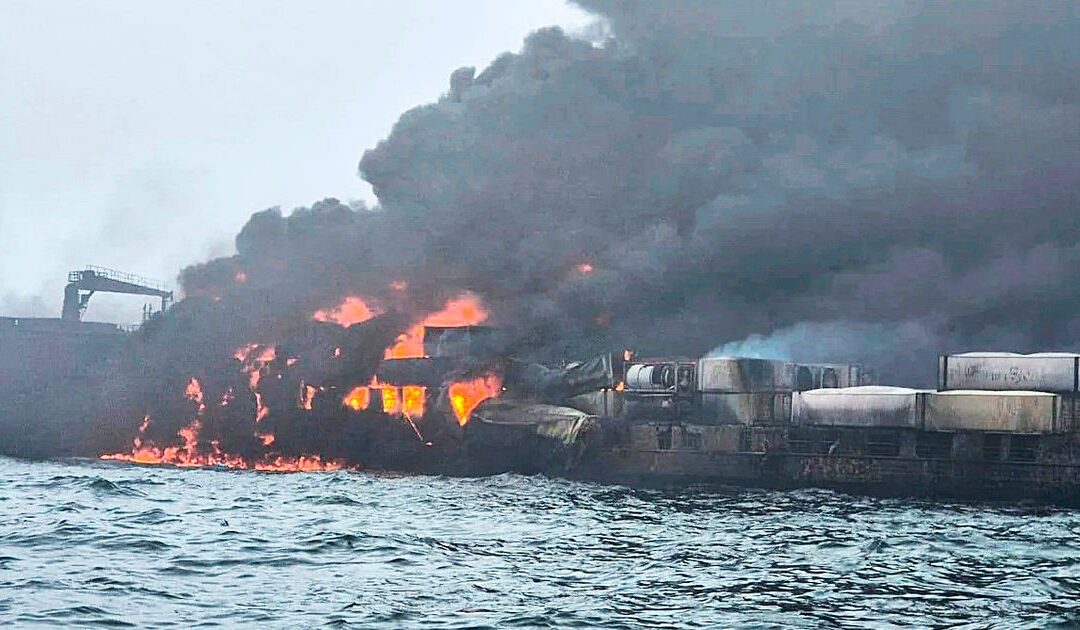Total insured losses out of the collision are estimated to range between $100 million and $300 million for all coverages, Canada-based global credit ratings agency Morningstar DBRS .
Focus is now shifting to the environmental impact of the blaze. While the incident is one of the most significant marine disasters in the UK for years, the country’s Health Security Agency said there is currently a very low risk to the public on shore
A US oil tanker that was struck by a container ship in the North Sea on Monday was smoldering with a gaping hole in its side, footage broadcast by BBC News showed.
Following significant damage, a fire, and a fuel spill in the North Sea,total insured losses out of the collision between a Portuguese-flagged containership and a US-flagged tanker, are estimated to range between $100 million and $300 million for all coverages, Canada-based global credit ratings agency Morningstar DBRS .
The rating agency estimated insured value of the ships, including salvage costs, between $50 million and $100 million.
The rating agency expects multiple insurance policies to be activated in response to the incident.
A large component of claims is expected to be paid by protection and indemnity (P&I) insurance, due to the environmental consequences of the fuel spill. Given the nature of this incident and the potential environmental impact, it is expected that P&I policies for both vessels will come into effect.
Hull and machinery (H&M) insurance will likely cover the structural damage to both vessels, with preliminary assessments suggesting they may be declared total losses.
According to Morningstar DBRS, members of the International Group of P&I Clubs share liability above a $10 million threshold, with additional reinsurance available for claims exceeding $3 billion.
“While this level of estimated losses is manageable for the global marine insurance industry, it raises concerns about the profitability of this business sector. However, we do not expect this event to materially affect the credit profile of marine insurers in 2025,” ” said Morningstar DBRS.
This is particularly true considering significant losses incurred from the collision of the cargo container ship Dali with the Francis Scott Key Bridge in Baltimore early last year, as well as the ongoing challenges with maritime traffic around the Red Sea and the Suez Canal. said the agency.
Focus is now shifting to the environmental impact of the blaze. While the incident is one of the most significant marine disasters in the UK for years, the country’s Health Security Agency said there is currently a very low risk to the public on shore.
An international oil-pollution compensation fund said the jet fuel being spilled from the Stena Immaculate, which was supplying fuel for the US navy, is categorized as “non-persistent” oil. That means it is more prone to evaporating when spilled and could indicate a less-severe environmental impact than would be the case for a cargo of heavy crude or ship fuel.
One crew member aboard the container ship, the Solong, is missing and the local coast guard called off a search for them on Monday night.
“Whilst the images look worrying, from the perspective of the impact to the aquatic environment, it’s less of a concern than if this had been crude oil because most of the jet fuel will evaporate very quickly,” said Mark Hartl, a Marine Ecotoxicologist from the Centre for Marine Biodiversity & Biotechnology at Heriot-Watt University.
“Also, the fact that it happened out at sea and not closer to land or within an estuary setting is fortuitous and will minimize the environmental impact.”
The Stena Immaculate, which was supplying 220,000 barrels of jet fuel for the US Navy, leaked an unknown quantity of its cargo as a result of the crash, its manager Crowley said on Monday. IOPC Funds, which pays out in the event of leaks, said it wouldn’t do so for a jet fuel spillage.
Footage on the BBC website on Tuesday showed a big hole in at least one of its tanks, although it didn’t appear there was immediate danger of the vessel sinking. Crowley said the tanker has 16 segregated tanks, something that might help to restrict the size of the spill.
Cargo Risk
The Solong was transporting fifteen containers of sodium cyanide, according to Lloyds List Intelligence. It can release gas when spilled into water, causing adverse health effects, according to the UK’s Health Security Agency.
The Solong’s owner didn’t immediately respond to questions about what was inside the containers that the vessel was transporting.
A local politician also told the BBC that the cargo on board the Solong still wasn’t clear. The first assumption is that the incident was caused by human error on the part of whoever was at the helm of the container ship, she added.
The area close to the incident plays home to a host of ecologically important sites, including a 50 kilometer glacial tunnel known as the Silver Pit, known for its abundant marine life as well as significant bird habitats.
“If pollution spillage enters the Humber, this could potentially be devasting for the wildlife of the estuary, including important fish stocks and tens of thousands of overwintering and migrating birds who use the mud flats,” said Martin Slater, director of operations at Yorkshire Wildlife Trust. “Many birds are gathering offshore on the sea ahead of the nesting season and we still have wintering waders – plus migrant birds stopping here.”
Associated British Ports said that shipping movements into the Humber estuary, which includes Immingham, Grimsby and Hull, resumed Monday evening after a halt earlier in the day. There are still some restrictions in the area, a spokesperson added.

